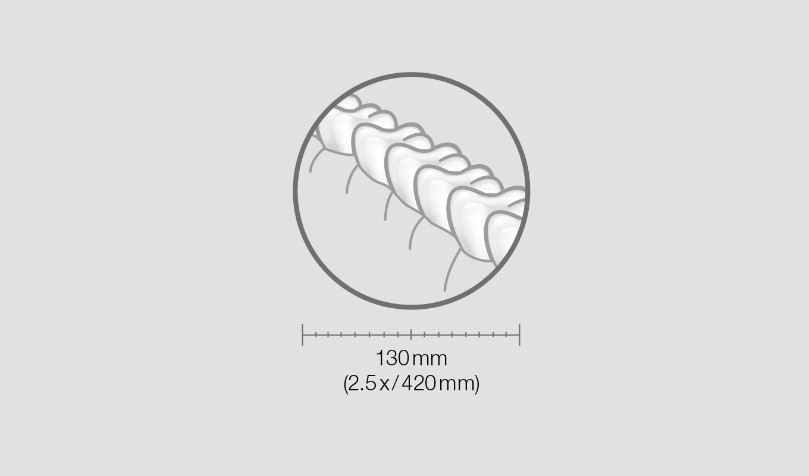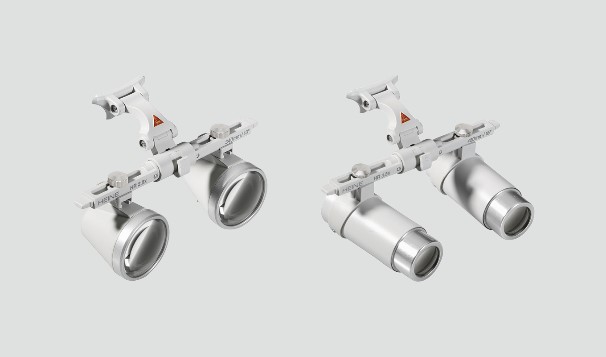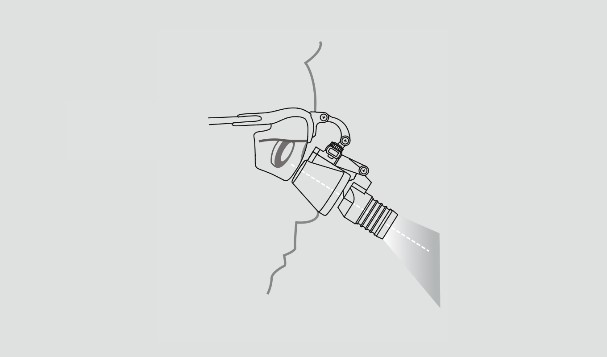
High precision and clarity of visualization are key factors for successful medical procedures. In areas such as dentistry, surgery, dermatology, ENT practice and veterinary medicine, doctors work with the smallest anatomical structures, where even the smallest error can affect the treatment outcome.
However, traditional methods of working without optical magnification are often accompanied by increased strain on the eyes, inaccuracy and discomfort due to forced tension in the muscles of the neck and back. Over time, this can lead to fatigue, errors and decreased efficiency.
The optimal solution is to use binocular loupes in combination with high-quality lighting. They significantly improve image detail, provide high precision and allow you to maintain an ergonomically correct posture, which reduces the physical strain on the doctor.
Modern binocular loupes adapt to the needs of the user and can be attached to a glasses frame or a helmet, providing maximum comfort at work.
When choosing binocular loupes, an important aspect is the ability to customize them for a specific user. This affects the comfort of work, ergonomics of the posture and the overall efficiency of the procedures.
There are two main types of loupes:
1. TTL loupes (Through-the-Lens) - an individual approach, but less flexibility
TTL loupes have a fixed design, since their optics are built directly into the lenses of the glasses and are adjusted to individual user parameters at the manufacturing stage. This ensures ideal centering of the optics and precise correspondence to the interpupillary distance for a specific user, without the need for additional adjustments.
However, due to this individuality, loupes cannot be adapted to another user, which can be a critical factor for public health institutions or clinics where the equipment is used by different specialists. In addition, if the interpupillary distance or working conditions change over time, TTL loupes cannot be adjusted - in this case, you will have to order a new pair.
2. Adjustable Binocular Loupes – Versatility and Comfort
Binocular loupes with adjustable interpupillary distance, such as HEINE HR and HRP, offer significantly greater flexibility in use.
Key benefits:
Versatility: Loupes are suitable for different users, as the interpupillary distance can be easily adjusted.
Adaptation to working conditions: The doctor can change the parameters depending on the type of procedure.
Ergonomics: Adjustable tilt angle reduces the strain on the neck and back, maintaining the correct posture.
Adjustable loupes allow you to maintain comfort and efficiency even during complex manipulations.
2. Key parameters for choosing the right binocular loupes.
When choosing binocular loupes to ensure effective work, two main factors must be taken into account: ergonomics and optical characteristics, they determine the comfort and efficiency of the doctor. These criteria include:
Magnification – the level of image detail.
Working distance – the optimal distance between the user’s eyes and the working area.
Angle of inclination and ergonomics – important for maintaining correct posture during work.
Optics and lighting quality – affects clarity, brightness and color accuracy.
2.1. Magnification
The most commonly used magnification is 2.5x. Lower magnification promotes better hand-eye coordination, and also provides a wider field of view and greater depth of field.
2.5x magnification is universal and is suitable for both beginners and experienced medical professionals. For those with more experience, it is recommended to use higher magnifications, in particular microsurgery.
The range of HEINE loupes ranges from 2.5x to 6x, which meets the needs of various medical fields, such as dentistry, surgery and other specialties where high accuracy and image detail are critical.
Table 1. Possible areas of application depending on the magnification of binocular loupes.
Specialization | Magnification | Possible areas of application |
ENT | 2.5x | Diagnosis and treatment of the ears and nose, such as procedures in the inner ear, sinuses |
Surgery | 2.5x, 3.5x, 4.0x | Plastic and reconstructive surgeries, transplantation, wound suturing, cardiac surgeries |
Microsurgery, neurosurgery | 4.0x, 6.0x | Delicate surgical procedures, such as operations on small vessels, nerve structures, or soft tissues |
Gynecology | 2.5x, 3.5x | Basic diagnostics and visualization of small details of the cervix, etc. |
4.0x, 6.0x | Surgical manipulations on small structures, such as laser therapy or removal of neoplasms, tissue biopsy | |
Ophthalmology | 2.5x | Plastic and reconstructive surgeries, such as blepharoplasty |
Dentistry | 2.5x | Restoration, implantology, periodontal surgical procedures, as well as during teeth cleaning |
3.5x, 4.0x | Detailed restorations, such as edge preparation in endodontics | |
6.0x | Endodontics, such as root canal treatment | |
Veterinary medicine | 2.5x | Oral cavity cleaning, urinary tract surgery |
2.2. Working distance and depth of focus
The term "working distance" means the distance from the eye to the working zone at which the image becomes clear (distance from the eye to the optimal working zone). For example, taller people who work standing need a greater working distance than someone who operates or conducts an examination while sitting.
The HEINE company offers an ideal working distance (x) for each application and user from 250 mm to 520 mm. The optimal working distance (x) does not depend on the size of the loupes, but on the physical parameters of the user and the type of procedure.
Depth of focus (y) is easily defined as the difference between the nearest and farthest distances at which the object remains in focus.
The advantage of HEINE magnifiers is a high focusing depth of up to 290 mm, which allows you to choose the most ergonomic working distance.

Working distance with HEINE binocular magnifiers: 340, 420 and 520 mm
2.3.1. Field of vision
HEINE magnifier systems have two key advantages: a large and balanced field of vision, as well as an optimal placement of the glasses in front of the eye. Folding systems of this type provide a wide field of view, while taking into account ergonomic requirements for comfortable work. This allows doctors to get a clear image without straining the eyes and neck.

2.1. Tilt angle and ergonomics
The deviation angle is the angle between the line of sight in the normal position of the eyes and the line of sight when the user lowers the eyes. It determines how steeply or gently the optics can be adjusted in use. The optimal angle is reached when the muscles of the neck and eyes are maximally relaxed, and the head, neck and back are in a straight position.

HEINE binocular magnifier systems provide maximum comfort through:
Adjustment of the angle of inclination: allows you to adjust the optics to a very steep or shallow angle, adapting it to the working needs of the user
Lightness of the design: dandruff and frames with coaxial LED lighting have a small weight, which reduces the load on the neck.
Ergonomic weight distribution: the S-shaped frame and the retaining cord evenly distribute the weight, which is important during prolonged use
Alternatively, if a headlamp is used, it must be aligned coaxially with the magnifiers, that is, their optics and light must be on the same axis relative to the field of view. This provides optimal illumination of the working area without shadows. HEINE magnifiers allow you to individually adjust the axis of the light flux in accordance with the axes of the magnifiers, which guarantees an ideal alignment of lighting in accordance with the user's preferences.
2.4. Quality of optics and lighting
2.4.1. Quality of optics
The choice of high-quality optics provides clear magnification without color distortions (rainbow effect).
HEINE HR — achromatic optics with high resolution and excellent optical properties.
HEINE HRP — prismatic optics with high resolution, provides magnification from 3.5x and the best image quality
HEINE magnifiers provide the brightest image among similar binocular models thanks to a special anti-reflective coating that reduces light reflection to 0.3%. This allows you to get extremely clear images and a wide depth of focus, ensuring optimal work without distortion even at the edges of the field of view.

2.4.2. Lighting quality
Illuminators for binocular magnifiers can be of different types, depending on the needs of the user:
Headlamps are attached to the helmet. They are usually used to provide direct and uniform illumination of the working area.
Frame-mounted illuminators are installed on magnifiers or on the frame, providing direct illumination of the inspection object.
Illuminators on the hoop - provide versatility in use and can be adjusted for optimal lighting.
High-quality LED sources provide the most natural color rendering, close to daylight. Cheap LEDs often have an excess of blue spectrum, which leads to color distortion.

Important parameters include:
Bright and uniform illumination of the entire working field without eclipses at the edges.
Clear, bright and uniform light without glare, excluding shadows and distortions.
Lighting quality, not just a high illuminance index (lux)
The correct arrangement of the light flux - the illumination must be perfectly aligned with the binocular magnifiers for maximum consistency.
Coaxial lighting ensures the absence of shadows, illuminating hard-to-reach areas, such as cavities, thanks to the parallel arrangement of the light beam of the visual axis. Thanks to the integration of the patented HEINE LEDHQ technology, 100% coaxial, white and uniform illumination is provided.
2.4.2.1. Variants of accumulators
Battery units with cable connection are usually used for magnifiers with illumination. The optimal choice is compact and light batteries that are conveniently worn on the body without restricting movement.
Main parameters:
Charge level indicator of autonomy control.
Brightness adjustment for precise lighting adjustment.
Ease of cleaning the battery.
Power sources for loupes with forehead lighting:
Battery packs on the belt are an economical option, increased mobility and comfort.
Wireless helmet solutions - maximum freedom of movement.
The convenience of helmet-mounted wireless batteries provide conditions for dynamic work without restrictions even in complex operations.
3. Auxiliary accessories for the convenience and efficiency of working with magnifiers
For the convenience and efficiency of working with binocular magnifiers and illuminators, there are a number of useful accessories. They allow you to configure the devices in accordance with the individual needs of the user and provide additional comfort during long procedures.
Table 2. Possible accessories for binocular magnifiers and illuminators
Accessory | Description |
Polarizing filters | Polarizing filters reduce glare, increase contrast, and enhance the visibility of veins, allowing for better visibility of the upper layers of the skin. They are optional extras for some models of loupes and headlamps, allowing for more precise and comfortable work during medical procedures. |
Yellow filters | The yellow filter reduces the amount of blue light, which can be useful in dentistry to prevent premature curing of composite materials exposed to light |
Sterilized removable levers | The levers allow the loupe to be raised without removing the entire frame (bar), allowing for a quick transition between magnification and normal view, for example during patient interaction. They are removable and minimize operator contact with the loupe, improving hygiene during procedures. |
Correction frames Clip-in | Clip-in corrective frames allow prescription glasses to be integrated into binocular magnifiers, which is especially useful for people with significant vision impairment. It is recommended to use corrective frames with glasses if there are serious vision problems |
Retaining cord for eyeglass frames | The fixation cord, which is attached to the temples and pulled up behind the head, helps distribute weight evenly, ensures a stable fit, and increases comfort while wearing. |
Therefore, the use of binocular loupes and illuminators in medical practice significantly improves the accuracy and efficiency of diagnostics. The choice of high-quality optics, for example, HEINE with achromatic lenses, guarantees a clear, bright image without color distortion, which is critically important in medicine and medical interventions.